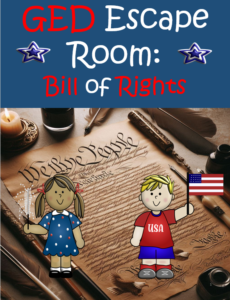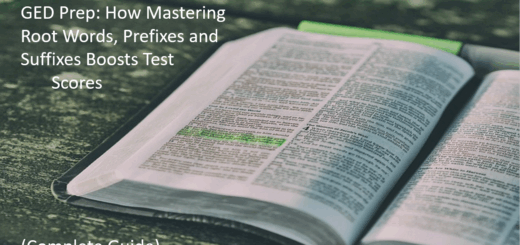Benefits of Escape Rooms in the GED Classroom

Fact #1: People learn better and retain more when they are having fun.
Fact #2: Adults like games too.
Fact #1 + Fact #2 = the reason why you should incorporate games, escape rooms in particular, into your GED classroom.
Escape rooms are a fun way to have fun AND create an accelerated learning environment. The benefits are numerous, but almost all Escape Rooms have the following benefits:

- Teamwork. Students must collaborate to solve puzzles, so they must work as a team, and working well as a team member is a soft skill that many employers highly value. Therefore, you are helping students work toward their GED while also preparing them for that next step — employment. In addition, teamwork helps your class become a community. Students make friends, and these new friends will be their support system as they study for the GED.

2. Communication Skills. To work as a team, students must learn to effectively communicate with one another. They must collaborate to solve puzzles, and these communication skills are improving their future employability as well as getting them ready for the writing portion of the GED. After all, writing is one form of communication, and sharpening this skill will help them better understand how to express their thoughts on the RLA (Reasoning through Language Arts) test.

3. The double P: Patience and Perseverance. A well-designed Escape Room will have some challenging tasks, so students may not solve clues on the first try. Teaching your learners the importance of not giving up is a skill they will need when they come across a tough GED lesson. Persistence is crucial if they are to learn their weakest subject, and that persistence will eventually help them earn their GED certificate. Patience and perseverance are also important life and work skills, so the benefits extend beyond the classroom.

4. Mood Boost. Escape rooms can actually be mood boosters. As students work as a team to solve problems, they are sure to build self-confidence, and this can lift their spirits. Many Escape Rooms will get students out of their seats and collaborating with classmates, an exercise that is much more exciting than working out of a textbook all day. Students will also be excited to attend the next class, since they know that not only will they be gaining knowledge, but they might actually have a little fun too.

5. Out-of-the-Box Thinking. Students will most likely have to think differently to solve certain puzzles: a great brain exercise and a great preparation for the math portion of the GED. My students who have tackled the GED math with the greatest amount of ease are great with conquering challenges. If they try to solve a problem and fail, they simply try a different strategy. Escape Rooms are conducive to this type of out-of-the-box thinking that can help them increase their problem-solving skills.

6. Time Management. Most escape rooms have a time limit, so students learn to accomplish tasks within a given amount of time. Since many GED testers feel added pressure with the test’s time limit, this provides good practice. If escape room participants can’t solve one puzzle, they learn to move on to the next one. This is very similar to good test-taking strategies that involve skipping the hard questions and coming back to them later.

7. Following Directions. Even though students may be under a time limit in their escape room, if they don’t pay careful attention to directions, they won’t be able to solve puzzles. Similarly, if testers don’t follow the directions on the GED test, they could possibly answer a question incorrectly. Escape rooms prepare learners for following directions even when the clock is ticking.

8. Attention to Detail. Learners must notice every little thing when solving puzzles in an escape room. Why is this writing in all caps? What is behind the chalkboard? Etc. Likewise, students will need to pay attention to small details when taking the GED test. Think about what a difference it can make in a math problem if you forget to include the negative sign in front of a number. Escape rooms prepare testers for taking a deep breath and taking it all in so that they can correctly answer questions.

9. Learning Styles. People learn differently, and escape rooms work for students with different types of learning styles. One puzzle may be a hands-on activity followed by a completely different challenge that utilizes auditory skills. Therefore, it is likely that one student in an escape room team might be great at one puzzle while a different team member is better able to solve a totally different type of brain teaser. In this way, escape rooms are superior to the typical lecture style of teaching, since everyone is better able to participate and learn.

10. Fun and Easy Teaching. For teachers, the best reason of all is that escape rooms make teaching easy and fun. Teachers simply act as facilitators, putting the learning into the students’ hands. Instructors can also increase their own classroom enjoyment as they watch their learners work collaboratively and have fun. There may even be opportunities for teachers to come dressed in character, ready to utilize their inner actor/actress.
If you haven’t yet used escape rooms in your class, you are missing out on some great learning opportunities and a lot of fun. Escape rooms are enjoyable to make, but the creation process can be time-consuming. Keep reading to learn about one of my pre-made escape rooms perfect for GED students.
How to play: Each group will start with 30 cards (the first 10 from pages 3-5 and all the cards on pages 8-12). They will be given a series of 10 puzzles to solve (pages 13-26). After solving each one correctly, the teacher will give the students an amendment card (from pages 5-7).
When students have collected all 10 amendment cards, they must correctly make 10 piles, one for each of the amendments in the Bill of Rights. Each pile will have one amendment card, one amendment definition, and one or more real-life example cards.
Once successfully done, they may “exit” the escape room.
Many of the puzzles give clues to help students correctly complete their final task.
The students will solve 10 puzzles:
- Word Search. Students must locate 10 of the 39 names of people who signed the Constitution.
- Math problem. The solution to the problem will tell the year the Bill of Rights were ratified.
- Word Scramble. Once all words are unscrambled, the students will discover a clue to knowing the 3rd amendment.
- Card Sorting. Students are given 3 mats, one for each of the three branches of government, and a set of cards that have a government power. Learners must put the power cards on the mat with the branch of government that has that power.
- Rebus. After solving, students will discover some of their 5th amendment rights.
- Decoding. Players use the highlighted letters in a copy of the preamble of the Constitution to find out what the 6th amendment guarantees.
- Term matching. Learners have to correctly match constitution-related terms to their definitions.
- Maze. Students must correctly make their way through a maze of terms in order to reveal the purpose of the 8th amendment.
- Cryptogram. Once solved, the main idea of the 9th amendment is revealed.
- Sentence Scramble. Players place the words in the correct order to find out more about the 10th amendment.
When all 10 puzzles are solved, students must use their 10 amendment cards that they earned after each puzzle and the 30 Bill of Rights cards they were given at the beginning of the game to create 10 piles, each having one amendment card, one amendment explanation, and one or more examples.
Here are a few pictures from the escape room packet:

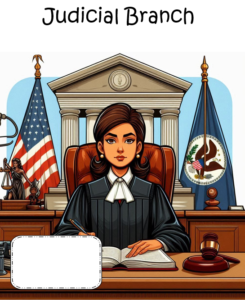
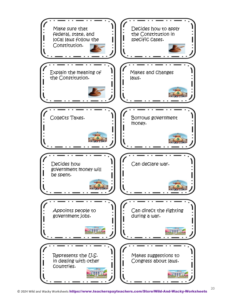
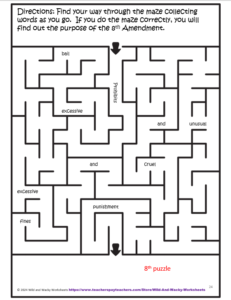
As always, click on the following link to check out all the resources in my TPT store.


